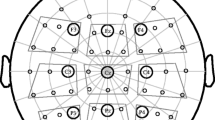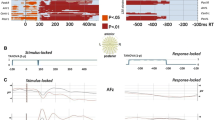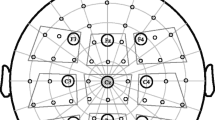Abstract
One of the most prominent symptoms of schizophrenia is thought disorder, which manifests itself in language production difficulties. In patients with thought disorders the associations are loosened and sentence production is impaired. The determining behavioral and neural mechanisms of sentence production are still an important subject of recent research and have not yet been fully understood. The aim of the current study was to examine the influence of associative relations and distractor modalities on sentence production in healthy participants and participants with schizophrenia. Therefore, reaction times and neural activation of 12 healthy subjects and 13 subjects with schizophrenia were compared in an adapted picture word interference paradigm (PWI). No significant group differences were found, neither on the behavioral nor on the neural level. On the behavioral level, for the entire group incremental sentence processing was found, i.e. processing of the second noun only starts after the first noun was processed. At the neural level, activation was discovered in the bilateral caudate nuclei and the cerebellum. Those activations could be related to response enhancement and suppression as well as to the modulation of cognitive processes.




Similar content being viewed by others
References
Tandon R, Gaebel W, Barch DM et al (2013) Definition and description of schizophrenia in the DSM-5. Schizophr Res 150(1):3–10. https://doi.org/10.1016/j.schres.2013.05.028
Kuperberg GR (2010) Language in schizophrenia Part 1: an introduction. Lang Linguistics Compass 4(8):576–589. https://doi.org/10.1111/j.1749-818X.2010.00216.x
Moro A, Bambini V, Bosia M et al (2015) Detecting syntactic and semantic anomalies in schizophrenia. Neuropsychologia 79(Pt A):147–157. https://doi.org/10.1016/j.neuropsychologia.2015.10.030
Covington MA, He C, Brown C et al (2005) Schizophrenia and the structure of language: the linguist’s view. Schizophr Res 77(1):85–98. https://doi.org/10.1016/j.schres.2005.01.016
Collins AM, Loftus EF (1975) A spreading-activation theory of semantic processing. Psychol Rev 82(6):407
Spitzer M, Braun U, Hermle L et al (1993) Associative semantic network dysfunction in thought-disordered schizophrenic patients. Direct evidence from indirect semantic priming. Biol Psychiatry 34(12):864–877. https://doi.org/10.1016/0006-3223(93)90054-H
Spitzer M (1997) A cognitive neuroscience view of schizophrenic thought disorder. Schizophr Bull 23(1):29–50
Manschreck TC, Maher BA, Milavetz JJ et al (1988) Semantic priming in thought disordered schizophrenic patients. Schizophr Res 1(1):61–66. https://doi.org/10.1016/0920-9964(88)90041-2
Kuperberg GR (2010) Language in schizophrenia Part 2: What can psycholinguistics bring to the study of schizophrenia… and vice versa? Lang Linguistics Compass 4(8):590–604. https://doi.org/10.1111/j.1749-818X.2010.00217.x
Rossell SL, Rabe-Hesketh SS, Shapleske JS et al (1999) Is semantic fluency differentially impaired in schizophrenic patients with delusions? J Clin Exp Neuropsychol 21(5):629–642. https://doi.org/10.1076/jcen.21.5.629.865
Kuperberg GR, Kreher DA, Ditman T (2010) What can event-related Potentials tell us about language, and perhaps even thought in schizophrenia? Int J Psychophysiol 75(2):66–76. https://doi.org/10.1016/j.ijpsycho.2009.09.005
Li X, Branch CA, DeLisi LE (2009) Language pathway abnormalities in schizophrenia: a review of fMRI and other imaging studies. Curr Opin Psychiatry 22(2):131–139. https://doi.org/10.1097/YCO.0b013e328324bc43
Szycik GR, Munte TF, Dillo W et al (2009) Audiovisual integration of speech is disturbed in schizophrenia: an fMRI study. Schizophr Res 110(1–3):111–118. https://doi.org/10.1016/j.schres.2009.03.003
Kuperberg GR, Deckersbach T, Holt DJ et al (2007) Increased temporal and prefrontal activity in response to semantic associations in schizophrenia. Arch Gen Psychiatry 64(2):138–151. https://doi.org/10.1001/archpsyc.64.2.138
Sass K, Heim S, Sachs O et al (2014) Neural correlates of semantic associations in patients with schizophrenia. Eur Arch Psychiatry Clin Neurosci 264(2):143–154. https://doi.org/10.1007/s00406-013-0425-0
Arcuri SM, Broome MR, Giampietro V et al (2012) Faulty suppression of irrelevant material in patients with thought disorder linked to attenuated frontotemporal activation. Schizophr Res Treatment 2012:176290. https://doi.org/10.1155/2012/176290
Ragland JD, Moelter ST, Bhati MT et al (2008) Effect of retrieval effort and switching demand on fMRI activation during semantic word generation in schizophrenia. Schizophr Res 99(1–3):312–323. https://doi.org/10.1016/j.schres.2007.11.017
Sass K, Heim S, Sachs O et al (2010) Why the leash constrains the dog: the impact of semantic associations on sentence production. Acta Neurobiol Exp(Wars) 70:435–453
Levelt WJM, Roelofs A, Meyer AS (1999) A theory of lexical access in speech production. Behav Brain Sci 22(1):1–38
Estes Z, Golonka S, Jones LL (2011) Thematic thinking: the apprehension and consequences of thematic relations. Psychol Learn Motivation Adv Res Theory 54:249
Lin EL, Murphy GL (2001) Thematic relations in adults’ concepts. J Exp Psychol Gen 130(1):3–28. https://doi.org/10.1037/0096-3445.130.1.3
Muehlhaus J, Heim S, Altenbach F et al (2014) Deeper insights into semantic relations: an fMRI study of part-whole and functional associations. Brain Lang 129:30–42. https://doi.org/10.1016/j.bandl.2014.01.003
Levelt WJM, Meyer AS (2000) Word for word. Multiple lexical access in speech production. Eur J Cogn Psychol 12(4):433–452. https://doi.org/10.1080/095414400750050178
Konopka AE (2012) Planning ahead. How recent experience with structures and words changes the scope of linguistic planning. J Mem Lang 66(1):143–162. https://doi.org/10.1016/j.jml.2011.08.003
Zhao L-M, Yang Y-F (2016) Lexical Planning in sentence production is highly incremental. Evidence from ERPs. PloS one 11(1):e0146359. https://doi.org/10.1371/journal.pone.0146359
Levelt WJ (2001) Spoken word production. A theory of lexical access. Proc Natl Acad Sci USA 98(23):13464–13471. https://doi.org/10.1073/pnas.231459498
Myers S, Robertson EK (2015) A Closer look at phonology as a predictor of spoken sentence processing and word reading. J Psycholinguistic Res 44(4):399–415. https://doi.org/10.1007/s10936-014-9292-8
Smith M, Wheeldon L (2004) Horizontal information flow in spoken sentence production. J Exp Psychol Learn Mem Cogn 30(3):675–686. https://doi.org/10.1037/0278-7393.30.3.675
Wagner V, Jescheniak JD, Schriefers H (2010) On the flexibility of grammatical advance planning during sentence production. Effects of cognitive load on multiple lexical access. J Exp Psychol Learn Mem Cogn 36(2):423–440. https://doi.org/10.1037/a0018619
Freunberger D, Nieuwland MS (2016) Incremental comprehension of spoken quantifier sentences: evidence from brain potentials. Brain Res 1646:475–481. https://doi.org/10.1016/j.brainres.2016.06.035
Konopka AE, Meyer AS (2014) Priming sentence planning. Cogn Psychol 73:1–40. https://doi.org/10.1016/j.cogpsych.2014.04.001
Muehlhaus J, Heim S, Sachs O et al (2013) Is the motor or the garage more important to the car? The difference between semantic associations in single word and sentence production. J Psycholinguistic Res 42(1):37–49. https://doi.org/10.1007/s10936-012-9209-3
Binder JR, Desai RH, Graves WW et al (2009) Where is the semantic system? A critical review and meta-analysis of 120 functional neuroimaging studies. Cerebral cortex (New York, N.Y.: 1991) 19(12):2767–2796. https://doi.org/10.1093/cercor/bhp055
Canini M, Della Rosa PA, Catricala E et al (2016) Semantic interference and its control: a functional neuroimaging and connectivity study. Hum Brain Mapp 37(11):4179–4196. https://doi.org/10.1002/hbm.23304
Abdel Rahman R, Melinger A (2007) When bees hamper the production of honey: lexical interference from associates in speech production. J Exp Psychol Learn Mem Cogn 33(3):604–614. https://doi.org/10.1037/0278-7393.33.3.604
Abdel Rahman R, Melinger A (2009) Semantic context effects in language production. A swinging lexical network proposal and a review. Lang Cogn Process 24(5):713–734. https://doi.org/10.1080/01690960802597250
Riley E, McMahon KL, Zubicaray G de (2015) Long-lasting semantic interference effects in object naming are not necessarily conceptually mediated. Front Psychol 6:578. https://doi.org/10.3389/fpsyg.2015.00578
Zubicaray G de, Johnson K, Howard D et al (2014) A perfusion fMRI investigation of thematic and categorical context effects in the spoken production of object names. Cortex 54:135–149. https://doi.org/10.1016/j.cortex.2014.01.018
Zubicaray G de, McMahon K, Eastburn M et al (eds) (2006) Top-down influences on lexical selection during spoken word production. A 4T fMRI investigation of refractory effects in picture naming. Hum Brain Mapp 27(11):864–873
Hocking J, McMahon KL, Zubicaray GI de (eds) (2009) Semantic context and visual feature effects in object naming. An fMRI study using arterial spin labeling. J Cogn Neurosci 21(8):1571–1583
Alario F-X, Chainay H, Lehericy S et al (eds) (2006) The role of the supplementary motor area (SMA) in word production. Brain Res 1076(1):129–143
Schwartz MF, Kimberg DY, Walker GM et al (2011) Neuroanatomical dissociation for taxonomic and thematic knowledge in the human brain. Proc Natl Acad Sci USA 108(20):8520–8524. https://doi.org/10.1073/pnas.1014935108
Zubicaray GI de, Hansen S, McMahon KL (2013) Differential processing of thematic and categorical conceptual relations in spoken word production. J Exp Psychol Gen 142(1):131–142. https://doi.org/10.1037/a0028717
Grande M, Meffert E, Schoenberger E et al (2012) From a concept to a word in a syntactically complete sentence. An fMRI study on spontaneous language production in an overt picture description task. NeuroImage 61(3):702–714. https://doi.org/10.1016/j.neuroimage.2012.03.087
Heim S, Eickhoff SB, Amunts K (2008) Specialisation in Broca’s region for semantic, phonological, and syntactic fluency? NeuroImage 40(3):1362–1368. https://doi.org/10.1016/j.neuroimage.2008.01.009
Heim S, Eickhoff SB, Friederici AD et al (2009) Left cytoarchitectonic area 44 supports selection in the mental lexicon during language production. Brain Struct Funct 213(4–5):441–456. https://doi.org/10.1007/s00429-009-0213-9
Humphreys GF, Gennari SP (2014) Competitive mechanisms in sentence processing. Common and distinct production and reading comprehension networks linked to the prefrontal cortex. NeuroImage 84:354–366. https://doi.org/10.1016/j.neuroimage.2013.08.059
Mirman D, Landrigan J-F, Britt AE (2017) Taxonomic and thematic semantic systems. Psychol Bull 143(5):499–520. https://doi.org/10.1037/bul0000092
Kircher TTJ, Oh TM, Brammer MJ et al (2005) Neural correlates of syntax production in schizophrenia. Br J Psychiatry 186(3):209–214
Wittchen H-U, Zaudig M, Fydrich T (1997) SKID. Strukturiertes klinisches Interview für DSM-IV. Achse I und II. Handanweisung, 1st edn. Hogrefe, Göttingen
Kay SR, Fiszbein A, Opler LA (1987) The Positive and Negative Syndrome Scale (PANSS) for Schizophrenia. Schizophr Bull 13(2):261–276. https://doi.org/10.1093/schbul/13.2.261
Schmidt K-H, Metzler P (1992) WST. Wortschatztest, 1st edn. Beltz Test, Weinheim
Aschenbrenner S, Tucha O, Lange KW (2001) RWT. Regensburger Wortflüssigkeits-Test. Handanweisung, 1st edn. Hogrefe, Göttingen
Tewes U (1991) HAWIE-R. Hamburg-Wechsler Intelligenztest für Erwachsene—Revision. Handbuch und Testanweisungen. Huber, Bern
Reitan R (1958) Validity of the trail making test as an indicator of organic brain damage. PMS 8(7):271. https://doi.org/10.2466/PMS.8.7.271-276
Brickenkamp R, Schmidt-Atzert L, Liepmann D (2010) Test d2-Revision. Aufmerksamkeits- und Konzantrationstest. Handanweisung, 1st edn. Hogrefe, Göttingen
Oldfield RC (1971) The assessment and analysis of handedness. The Edinburgh inventory. Neuropsychologia 9(1):97–113. https://doi.org/10.1016/0028-3932(71)90067-4
Maß R (2001) ESI. Eppendorfer Schizophrenie-Inventar, 1st edn. Hogrefe, Göttingen
Szekely A, Damico S, Devescovi A et al (2005) Timed action and object naming. Cortex 41(1):7–25. https://doi.org/10.1016/S0010-9452(08)70174-6
Heim S, Amunts K, Mohlberg H et al (2006) Head motion during overt language production in functional magnetic resonance imaging. Neuroreport 17(6):579–582
Cohen I (2004) Multichannel post-filtering in nonstationary noise environments. IEEE Trans Signal Process 52(5):1149–1160. https://doi.org/10.1109/TSP.2004.826166
Cusack R, Cumming N, Bor D et al (2005) Automated post-hoc noise cancellation tool for audio recordings acquired in an MRI scanner. Hum Brain Mapp 24(4):299–304. https://doi.org/10.1002/hbm.20085
Ternström S (2005) Does the acoustic waveform mirror the voice? Logop Phoniatr Vocol 30(3–4):100–107. https://doi.org/10.1080/14015430500238400
Howard DM (2005) Discussant response to ‘Does the acoustic waveform mirror the voice?’ Logop Phoniatr Vocol 30(3–4): 108–113. https://doi.org/10.1080/14015430500358570
Duyck W, Anseel F, Szmalec A et al (2008) Improving accuracy in detecting acoustic onsets. J Exp Psychol Hum Percept Perform 34(5):1317–1326. https://doi.org/10.1037/0096-1523.34.5.1317
Rastle K, Davis MH (2002) On the complexities of measuring naming. J Exp Psychol Hum Percept Perform 28(2):307–314. https://doi.org/10.1037//0096-1523.28.2.307
Henseler I, Mädebach A, Kotz SA et al (2014) Modulating brain mechanisms resolving lexico-semantic Interference during word production: a transcranial direct current stimulation study. J Cogn Neurosci 26(7):1403–1417. https://doi.org/10.1162/jocn_a_00572
Eickhoff SB, Stephan KE, Mohlberg H et al (2005) A new SPM toolbox for combining probabilistic cytoarchitectonic maps and functional imaging data. NeuroImage 25(4):1325–1335. https://doi.org/10.1016/j.neuroimage.2004.12.034
Salavera C, Puyuelo M, Antonanzas JL et al (2013) Semantics, pragmatics, and formal thought disorders in people with schizophrenia. Neuropsychiatr Dis Treatment 9:177–183. https://doi.org/10.2147/NDT.S38676
Manoach DS (2017) Cognitive deficits in schizophrenia. In: Reference module in neuroscience and biobehavioral psychology. Elsevier. http://nmr.mgh.harvard.edu/manoachlab/pubs/Manoach_cognition_sz_2017.pdf. Accessed 7 Aug 2018
Tremblay P, Dick AS (2016) Broca and Wernicke are dead, or moving past the classic model of language neurobiology. Brain Lang 162:60–71. https://doi.org/10.1016/j.bandl.2016.08.004
Zimmerer VC, Watson S, Turkington D et al (2017) Deictic and Propositional Meaning-New Perspectives on Language in Schizophrenia. Front Psychiatry 8:17. https://doi.org/10.3389/fpsyt.2017.00017
Price CJ (2010) The anatomy of language: a review of 100 fMRI studies published in 2009. Ann N Y Acad Sci 1191:62–88. https://doi.org/10.1111/j.1749-6632.2010.05444.x
Crosson B (2013) Thalamic mechanisms in language: a reconsideration based on recent findings and concepts. Brain Lang 126(1):73–88. https://doi.org/10.1016/j.bandl.2012.06.011
Hebb AO, Ojemann GA (2013) The thalamus and language revisited. Brain Lang 126(1):99–108. https://doi.org/10.1016/j.bandl.2012.06.010
Marien P, Ackermann H, Adamaszek M et al (2014) Consensus paper: Language and the cerebellum: an ongoing enigma. Cerebellum 13(3):386–410. https://doi.org/10.1007/s12311-013-0540-5
Moore AB, Li Z, Tyner CE et al (2013) Bilateral basal ganglia activity in verbal working memory. Brain Lang 125(3):316–323. https://doi.org/10.1016/j.bandl.2012.05.003
Crosson B, Benefield H, Cato MA et al (2003) Left and right basal ganglia and frontal activity during language generation: contributions to lexical, semantic, and phonological processes. J Int Neuropsychol Soc 9(7):1061–1077. https://doi.org/10.1017/S135561770397010X
Eickhoff SB, Heim S, Zilles K et al (2009) A systems perspective on the effective connectivity of overt speech production. Philos Trans Ser A Math Phys Eng Sci 367(1896):2399–2421. https://doi.org/10.1098/rsta.2008.0287
Moro A, Tettamanti M, Perani D et al (2001) Syntax and the brain: disentangling grammar by selective anomalies. NeuroImage 13(1):110–118. https://doi.org/10.1006/nimg.2000.0668
Ali N, Green DW, Kherif F et al (2010) The role of the left head of caudate in suppressing irrelevant words. J Cogn Neurosci 22(10):2369–2386. https://doi.org/10.1162/jocn.2009.21352
Argyropoulos GP, Tremblay P, Small SL (2013) The neostriatum and response selection in overt sentence production. An fMRI study. NeuroImage 82:53–60. https://doi.org/10.1016/j.neuroimage.2013.05.064
Friederici AD (2006) What’s in control of language? Nat Neurosci 9(8):991–992. https://doi.org/10.1038/nn0806-991
Groenholm EO, Roll MC, Horne MA et al (2016) Predominance of caudate nucleus lesions in acute ischaemic stroke patients with impairment in language and speech. Eur J Neurol 23(1):148–153. https://doi.org/10.1111/ene.12822
Duffau H, Moritz-Gasser S, Mandonnet E (2014) A re-examination of neural basis of language processing: proposal of a dynamic hodotopical model from data provided by brain stimulation mapping during picture naming. Brain Lang 131:1–10. https://doi.org/10.1016/j.bandl.2013.05.011
Robles SG, Gatignol P, Capelle L et al (2005) The role of dominant striatum in language: a study using intraoperative electrical stimulations. J Neurol Neurosurg Psychiatry 76(7):940–946. https://doi.org/10.1136/jnnp.2004.045948
Andreasen NC, Pierson R (2008) The role of the cerebellum in schizophrenia. Biol Psychiatry 64(2):81–88. https://doi.org/10.1016/j.biopsych.2008.01.003
Kuperberg GR, Delaney-Busch N, Fanucci K et al (2017) Priming p roduction. Neural evidence for enhanced automatic semantic activity preceding language production in schizophrenia. NeuroImage Clin. https://doi.org/10.1016/j.nicl.2017.12.026
Heim S, Eickhoff SB, Amunts K (2009) Different roles of cytoarchitectonic BA 44 and BA 45 in phonological and semantic verbal fluency as revealed by dynamic causal modelling. NeuroImage 48(3):616–624. https://doi.org/10.1016/j.neuroimage.2009.06.044
Wensing T, Cieslik EC, Müller VI et al (2017) Neural correlates of formal thought disorder. An activation likelihood estimation meta-analysis. Hum Brain Mapp 38(10):4946–4965. https://doi.org/10.1002/hbm.23706
Indefrey P, Hagoort P, Herzog H et al (2001) Syntactic processing in left prefrontal cortex is independent of lexical meaning. NeuroImage 14(3):546–555. https://doi.org/10.1006/nimg.2001.0867
Hagoort P, Indefrey P (2014) The neurobiology of language beyond single words. Ann Rev Neurosci 37:347–362. https://doi.org/10.1146/annurev-neuro-071013-013847
Heim S, van Ermingen M, Huber W et al (2010) Left cytoarchitectonic BA 44 processes syntactic gender violations in determiner phrases. Hum Brain Mapp 31(10):1532–1541. https://doi.org/10.1002/hbm.20957
Friederici AD (2006) The neural basis of language development and its impairment. Neuron 52(6):941–952. https://doi.org/10.1016/j.neuron.2006.12.002
Friederici AD, Fiebach CJ, Schlesewsky M et al (2006) Processing linguistic complexity and grammaticality in the left frontal cortex. Cereb Cortex (New York, N.Y.: 1991) 16(12):1709–1717. https://doi.org/10.1093/cercor/bhj106
Friederici AD, Gierhan SME (2013) The language network. Curr Opin Neurobiol 23(2):250–254. https://doi.org/10.1016/j.conb.2012.10.002
Santi A, Grodzinsky Y (2010) fMRI adaptation dissociates syntactic complexity dimensions. NeuroImage 51(4):1285–1293. https://doi.org/10.1016/j.neuroimage.2010.03.034
Santi A, Friederici AD, Makuuchi M et al (2015) An fMRI study dissociating distance measures computed by Broca’s area in movement processing. Clause boundary vs. identity. Front Psychol 6:654. https://doi.org/10.3389/fpsyg.2015.00654
Kircher TTJ, Leube DT, Erb M et al (2007) Neural correlates of metaphor processing in schizophrenia. NeuroImage 34(1):281–289. https://doi.org/10.1016/j.neuroimage.2006.08.044
Bzdok D, Meyer-Lindenberg A (2018) Machine learning for precision psychiatry. Opportunities and challenges. Biological psychiatry. Cogn Neurosci Neuroimaging 3(3):223–230. https://doi.org/10.1016/j.bpsc.2017.11.007
Acknowledgements
This work was supported by the German Research Foundation (DFG, IRTG 1328), the START Program (Grant Number 690934) of the Faculty of Medicine at RWTH Aachen University, and the IZKF Aachen (Interdisciplinary Center for Clinical Research within the Faculty of Medicine at RWTH Aachen University). We appreciate the valuable input we received from Katharina Sass on issues of the neurolinguistics of semantic processing. Furthermore, we thank Uli Heuter and Fabian Altenbach for technical support with the behavioral data analysis and André Schüppen from the Core Facility IZKF for Interdisciplinary Clinical Research for recommendations on imaging analysis.
Author information
Authors and Affiliations
Corresponding author
Ethics declarations
Conflict of interest
The authors declare that they have no conflict of interest.
Ethical Standards
The study has been approved by the ethics committee of the University Clinic, RWTH Aachen University, Germany and has been conducted according to the ethical standards laid down in the Declaration of Helsinki. All subjects gave their informed consent prior to inclusion in the study.
Rights and permissions
About this article
Cite this article
Creyaufmüller, M., Heim, S., Habel, U. et al. The influence of semantic associations on sentence production in schizophrenia: an fMRI study. Eur Arch Psychiatry Clin Neurosci 270, 359–372 (2020). https://doi.org/10.1007/s00406-018-0936-9
Received:
Accepted:
Published:
Issue Date:
DOI: https://doi.org/10.1007/s00406-018-0936-9




